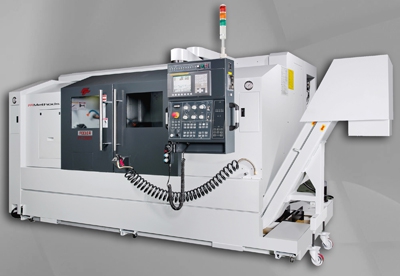
Methods Machine Tools Inc. has expanded its FEELER FT-Series high-performance CNC turning centers line with the new FT-250SY. A unique capability in its class, the FT-250SY features a true Y-Axis with 100mm (+/- 50mm) of travel, which provides increased rigidity and a more robust machining environment. Also, by offering an 8-inch sub-spindle in addition to the primary 10-inch spindle, the FT-250SY provides more capacity than competitive turning centers.
For excellent vibration dampening when turning in hard materials, including interrupted cutting, the FT-250SY features a single-piece structure with boxways, 45-degree slant bed and robust base. Extra rigidity from a heavy duty 12-station turret results in high metal removal rates, superb finishes, and ensures long term accuracy. For maximum integrity, FEA analysis is used to ensure a solid machine base with excellent overall structural rigidity and stability. The machine also offers exceptional capacity with a 30 HP, 3,500 RPM 10-inch (chuck diameter) primary spindle in addition to a 20 HP, 4,500 RPM 8-inch (chuck diameter) sub-spindle.
"The FT-250SY is a valuable addition to the FEELER FT Series, providing exceptional rigidity and capacity at an economical price," said Dale Hedberg, FEELER Product Manager, Methods Machine Tools.
The FEELER FT-250SY offers an X-Axis travel of 8.2" +/- .3" (210mm +/- 10mm), Y-Axis travel of 3.9" +/- 2" (100mm +/- 50mm), and a 41.3" (1050mm) Z-Axis travel. The machine comes standard with a FANUC 31i-TB CNC. A BMT-65 tool system features a solid interface for tool holding. For maximum machine component longevity, a fully enclosed CE cabinet prevents dust and fumes from entering.
Contact Details
Related Glossary Terms
- centers
centers
Cone-shaped pins that support a workpiece by one or two ends during machining. The centers fit into holes drilled in the workpiece ends. Centers that turn with the workpiece are called “live” centers; those that do not are called “dead” centers.
- computer numerical control ( CNC)
computer numerical control ( CNC)
Microprocessor-based controller dedicated to a machine tool that permits the creation or modification of parts. Programmed numerical control activates the machine’s servos and spindle drives and controls the various machining operations. See DNC, direct numerical control; NC, numerical control.
- turning
turning
Workpiece is held in a chuck, mounted on a face plate or secured between centers and rotated while a cutting tool, normally a single-point tool, is fed into it along its periphery or across its end or face. Takes the form of straight turning (cutting along the periphery of the workpiece); taper turning (creating a taper); step turning (turning different-size diameters on the same work); chamfering (beveling an edge or shoulder); facing (cutting on an end); turning threads (usually external but can be internal); roughing (high-volume metal removal); and finishing (final light cuts). Performed on lathes, turning centers, chucking machines, automatic screw machines and similar machines.







